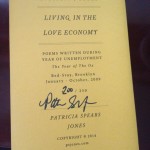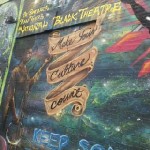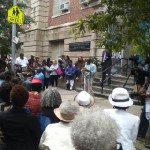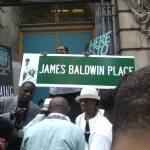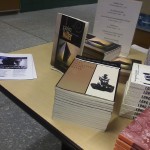This is a year when airplanes dropped out the sky and just disappeared. Where Russian troops in Crimea pretended to not be Russian troops in Crimea. Where ACA almost died under the weight of lousy internet interface. It is a year with news of horrific rape, murder and abduction and it ends with rape allegations against an aging comedian. It is a year when
a generation of poets, activists and actors in their 70s, 80s and 90s left us and where younger ones died by their own hand or via drugs. It was a year that seem to to be like a over heated dressage-many obstacles to leap over; many traps to gallop through. This is the year I learned to be used to be an orphan, a position I so do not like being.
All of those awful, terrible, scary things were backdrop to what may be one of my most productive and accomplished year:
I have a new chapbook, Living in the Love Economy from Overpass Books, young people who are graduates of Long Island University–they studied with Lewis Warsh, who was on of my first poetry instructors when I came to NYC in 1974! The book launch at Berl’s was well attended and I was able to get Anselm Berrigan and Erica Hunt to share the spotlight. I thank them all.
Poems were published in The Cataramaran Literary Reader, The Recluse from The Poetry Project and The Mas Tequila Review.
Serious literary interviews were made with me by Lewis Warsh for The Otter and Rochelle Spencer for Mosaic and The Brooklyn Poets interviewed and featured me for the Brooklyn Poet of the Week (that was fun). The most interesting interview was actually a dialogue with Afaa Michael Weaver for the Furious Flower Poetry Center’s archive. And after harrassing, well gently needling Metta Sama, she pulled together this extraordinary convo that Monica Hand, Tracy Chiles McGhee, Raquel Goodison and Ruth Ellen Kocher on women’s creativity, artistic production and well read it at http://theconversant.org/staging/?cat=782.
Rich Blint of Columbia University asked me to participate in a panel for the The Year of Baldwin portion of The Harlem Bookfair. Aimee Meredith Cox moderated the panel and I have to say again that she may have been the best panel moderator I have ever encountered. It was a lively and fresh conversation between me, Christopher Winks and Kiese Laymon. And earlier in the year I participated in the National Black Writers Conference at Medgar Evers College–that was fascinating esp. seeing Derek Walcott up close.
I blogged for the “Harriet” blog for the National Poetry Foundation in September. What did I know that in September the #Ferguson protests would start up; that I would have some impact on supporting the work of activists or that I’d write up Maya Angelou’s Riverside Church Memorial or that I’d talk about Sonia Sanchez’ 80th birthday or have the chance to report on the Furious Flower Poetry Conference with a focus on what happened after the public events took place! Reading and participating at Furious Flower was important for me as a poet, esp. as a Black poet. I also wrote literary reviews for books by Tony Medina and Yuko Otomo and arts reviews on Dawoud Bey and Carrie Mae Weems.
In August I had the great gift of 10 days at the Virginia Center for the Creative Arts where I put together a next to final draft of my New and Selected Poems with the great help of the VCCA staff–thank you again. I got to know Kelle Groom, Nichole Parcher, Joelle Wallach and other poets/composers, visual artists. And in October, I was able to fulfil my duties as a Senior Fellow for the Black Earth Institute and share in the wonderful hospitality of Michael McDermott and Charlotte Taymor in Wisconsin. The BEI gave its first ever award to Joy Harjo who was skyped in for the event–ah technology.
And also at VCCA I completed a commission–a new poem for a literary supplement to the forthcoming re-installment of The Migrations Series, Jacob Lawrence’s groundbreaking work that will be shown at the Museum of Modern Art. I thank Elizabeth Alexander for placing me in this august group. I had written about Lawrence’s work in an earlier poem which Quincy Troupe published in Black Renaissance Noir. It was a great opportunity and pretty scary-like will I pull this off? I did.
And I also worked with Atim Oton who is bringing her CALABAR brand to my hood, Bed-Stuy and so for the popup I developed a reading series, WORDS SUNDAY and it was really successful, But special shoutout to Janice Lowe who was in the first one, I want you back for a larger audience come Spring 2015.
And finally, I did readings for Paul Romero’s Bryant Park Series, most notably a “Lunch Poem” one with Jocelyn Lieu, Lydia Cortes, Jessica Greenbaum and Sharan Strange. And with Mark Statman for Neil Silbrerblatt’s Voices in Poetry series in Katonah. Rowan Ricardo Phillips brought me to SUNY Stony Brook, where June Jordan and Cornelius Eady advanced contemporary poetry. Getting to know Rowan and his work has been a boon. Also read “The Day Lady Died” for the Frank O’Hara Lunch Poem Publication Anniversary event at the Poetry Project. And at the end of the year I read at KBG with Shanna Compton–it was a night rich with verbal fireworks and deep emotions. There was more, but it’s cold. It’s December 31. It’s time to sum stuff up.
I know that much of this year has been about violence, danger, death and protest. I am sad about the danger, death and violence, but I am so pleased that protests are underway and not just here from Mumbai to Santiago Chile to Hong Kong to St. Louis, Missouri young people are awake and demanding their future–not one of fewer economic prospects, more debt; tyrannical police, environmental degradation; expensive consumerism and shoddy services–but one that may be more equitable, caring and creative. The world has always been violent and dangerous, but cynicism simply keeps whoever is in power in power. I thank young people for starting to say nada mas, no more. Yes #blacklivesmatter, Yes #afutureisinourhands. 2015 HERE WE COME.
